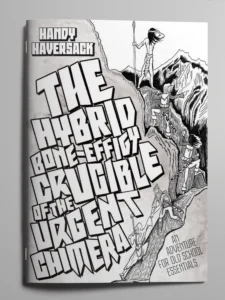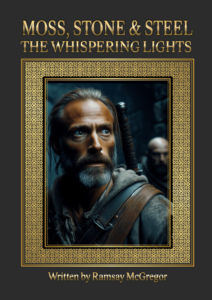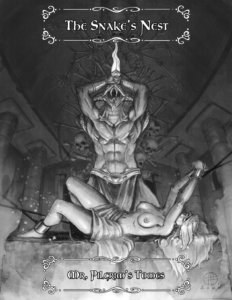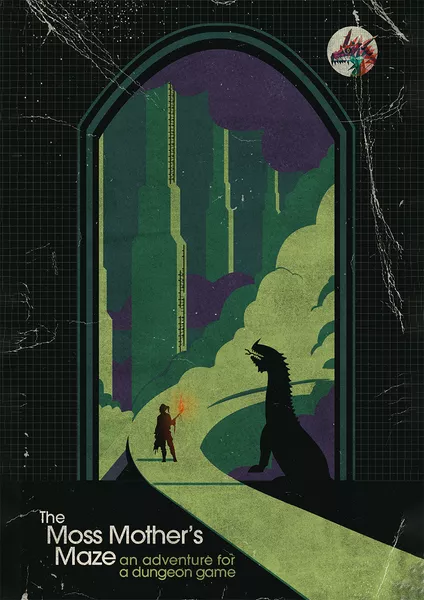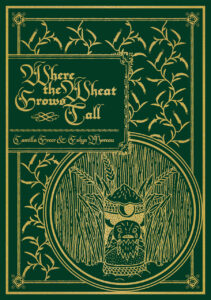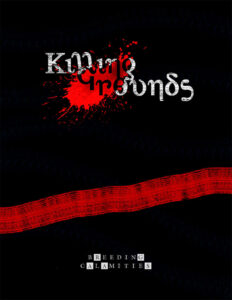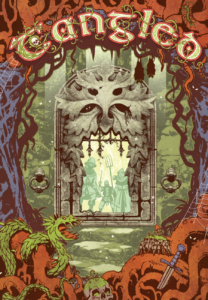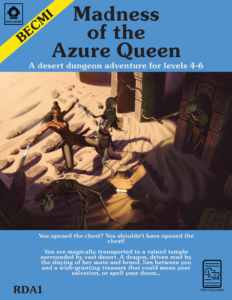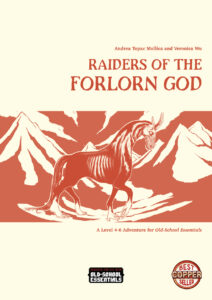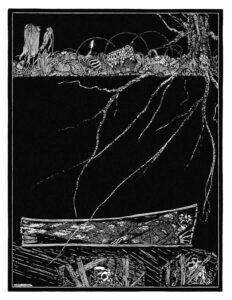
By Hex Girl
Melusine Press
OSR
Levels 1-3
A sleepy village in the Kingdom of Metz has been beset with strange happenings and nightmarish disappearances. Children have gone missing, phantasmagoria haunts the woods, and in the night and fog livestock is slaughtered, homes ransacked, and villagers dragged screaming into the hills. The comte Gunthigis has offered a substantial treasure to any who can rid his lands of this evil.
This 29 page adventure details a barrow crawl with two levels and about seventy rooms. Good focus on the writing towards gameable detail, but lacking in interactivity other than hacking and some talking. And, a misspent village that had potential.
This thing has you adventuring in a more realistic, but still fantasy, setting around 550AD europe. Franks, Frisians, and a roman history, as well as the pre-roman history are involved here. The farming village the adventure takes place around has about twenty families and no road leads there. Rural, isolated, some history behind things. This is still fantasy, with skeletons, a wraith, carrion crawler and so forth, but, also, bandits and wolves. It’s got a great little vibe going on where the village is sane (well, except for the massacres …) and the countryside gets a little wilder before you go off in to the barrow to meet fantasy. I’m really digging it.
The village has some issues. People disappearing and some really bloody livestock killings. A homestead burned down. People are afraid and sleep in the big house at night. The villagers are pretty decent. An old warrior/reeve, shoulders slumped, his village in peril and him unlikely to be effective, out of 13th warrior. And the villagers mostly focus on their interactions with the party. “Blanchard’s farm: A weatherbeaten farmhouse and barn. Blanchard is long in his grave; the widow Salla raises their young son Eberhard as best she can. Salla offers her barn to adventurers for free but Eberhard will attempt to join them on their adventurers – something Salla will vehemently discourage.” Or the farm lass that makes eyes at the party members … which can cause problems. They are almost all some little way to spice up the interactions between the villagers and the party. It’s some tight writing, or feels like it anyway, and does a great job keeping things focused on the adventure. It could, perhaps, use just a bit more, a timeline or some other events, lie a raid or something. The possibilities are there; there is a potential for skulking bandits or a raid by bandits or skeletons. But these are in their individual wilderness descriptions for the most part. Just a tad more here to bring the village panic to life would have been good. But, also, we’ve got a dude that maybe burned him family alive to avoid the raids and at least one missing person who is not really missing, or, not missing as a part of the main “plot” These are all great little touches to drive play and discovery.
The party will need to find the barrow and/or go looking in the countryside, a kind of “square crawl” and this part, the encounters here, are pretty decent also. Skulking bandits afraid of action. SOme escaped convicts, condemned to death, two murderers and an adultress. Still wearing chains and looking for some blacksmith action to free themselves. What to do, what to do? A giant spider with the face of an ogre! That’s great! And a troll who’s captured a human woman, one of the people missing from the village, to be his cook. He likes cooked meat but is afraid of fire. Again, maybe a sentence more in each of these, which again are pretty tightly written, would have kicked them even more. Just another complications for each would have been great.
We get to the barrow and things stay … ok. The writing remains tight and the descriptions here are pretty good. Two adjacent rooms read “4. Cavern: Dirt, exposed root structures and several skeletons recently picked clean. Bore-holes in the cave wall from something burrowing inward.
5. Cavern: A charnel pit of gore-streaked bones, human and animal. Flies buzz incessantly and the stench is rancid and overpowering.” A carrion crawler lurks about! A hint and then a monster, and then a decent but terse description to go with them. We’re not winning awards with the evocative text, but this is miles and miles better than most text we get in adventures. In the catacombs there are “Rectangular alcoves with Gaulish mummies spilling out onto the Floor” SPILLING out onto the floor. Not bad at all.
Interactivity here is a bit lacking. There are things to stab, of course, and sometimes a skeleton to talk to. But not a whole lot beyond that. Stretching the definition, seeing silver bars at the bottom of a pool of water … will lead to a fight if you mess with them. Wyvern eggs in a steam room, with mama next door .. I think that falls in to a fight to me, although, not exactly just an enter the room and start stabbing kind. Beyond this though the interactivity falls off a lot.
I can also nitpick a lot. Cross-references, for NPC’s and rooms, are sorely needed and the one place I noticed them they were wrong. There is, though, a great follow up. You MIGHT be offered the hand of the daughter of the Earl in marriage. She is almost certainly not inclined. And if so then she will arrange “12-48 armoured and missile footmen to track down the homestead of the groom/groom-to-be, setting fire to structures and indiscriminately killing family Members.” And if she fails she’ll try again in 1-3 years. Noice! Great follow up, complete with a reaction roll at -4 from her!
I’m a fan of what’s going on here. The tone. The giant spider with the ogre face, the wolves who kind of respect elves. The troll and his cook. It’s not just a book monster to stab. The writing is tight, evocative enough to not be throw-away, and focused on gameable activities. The barrow needs just a little more, in terms bringing it to life, as do the village and wilderness encounters. Just a little. I could go either way on this one. But, also, I’m an ass. No regerts about that.
This is $5 at DriveThru. You get all of the pages as a preview, so GREAT preview. Check out those villagers on the first few pages, or the wilderness encounters after that. A great thing taken all together.
https://www.drivethrurpg.com/en/product/497363/i1-death-walks-the-hills?1892600

